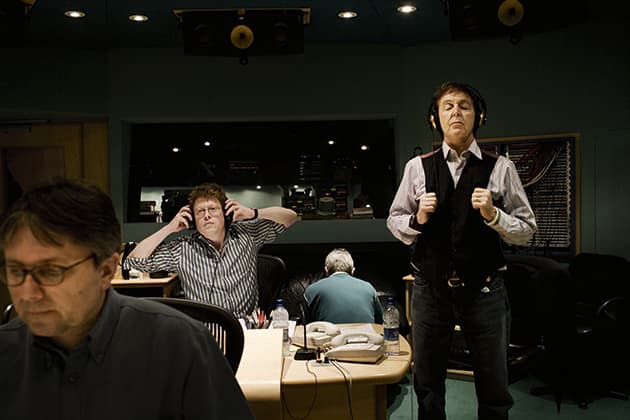The invitation to photograph Sir Paul McCartney came out of the blue. It was a Thursday afternoon in March 2006 and I was on a train, heading back home to Devon after a shoot in London. The sun was shining and I was daydreaming. The train had just pulled out of Reading when my mobile rang.
It was Paul McCartney’s agent, asking if I would like to photograph him the following morning at Abbey Road Studios in London. He was recording his classical album Ecce Cor Meum (Behold My Heart) and wanted some reportage-style shots of the recording process for the album artwork.
As someone primarily known as a portrait photographer, I was surprised to get the call. I’d recently photographed Heather Mills, to whom McCartney was married at the time, so I assumed there may have been a connection between the two shoots.
However, at the moment the offer came, I’d just completed a tiring shoot in London and was looking forward to a long weekend at home. I thanked the publicist for the offer but said, ‘I think I’ll pass on this one.’
While on the journey, I phoned my agent and mentioned that I’d turned down the offer to photograph Paul McCartney. He said, ‘Are you mad? Phone him back now and tell him you’ll do it!’
I realised I’d made a mistake, so I rang McCartney’s agent and said, ‘I don’t know what I was thinking: it’s a great opportunity and I’d love to photograph him.’ Then I went home, had dinner and travelled 200 miles back up the track to London. I stayed overnight and then went to Abbey Road [Studios] the next morning.
When I arrived, the publicist made it clear that McCartney wanted me to photograph only what was happening and not to interact with anyone or give any direction. Although this was completely different to the way I normally worked, it meant I was free for the whole morning to roam around the studio, photographing McCartney, the choir and the orchestra.
In the studio
It really was a pleasure and a privilege to be there. McCartney’s importance in musical history is unquestionable, and it was brilliant listening to a full orchestra and classically trained singers performing. To be in such a unique position and to actually be paid for being there was amazing.
My favourite picture from the shoot shows McCartney listening to the playback on headphones, surrounded by Abbey Road sound engineers and technicians. I just happened to go into the studio at that moment and quickly grabbed the shot. It was a genuine moment and I don’t think McCartney was even aware I was taking it.

Harry photographed Paul once again some months later, this time in the company of musician Pete Doherty
I had just started using a Canon EOS-1Ds Mark II and shot it with a 35mm lens. I only used available light, which was tricky because the studio was quite dark and only lit with spotlights. Luckily, the light wasn’t unflattering on McCartney’s face, and, as I always do in these situations, I exposed for the highlights. The settings for this shot were 1/30sec at f/5 and ISO 1,000, and I was handholding the camera. The image is quite sharp, so I must have rested the camera on a mixing desk or chair for added stability.
By coincidence, I photographed McCartney a second time about 18 months later, in a shoot for the Observer Music Monthly. He was to be interviewed by Pete Doherty, the singer and musician best known as the frontman for the Libertines. Doherty had been allowed out of rehab to interview him, so it was a great opportunity to photograph the two of them together, even though they made an incongruous pair.
The second encounter
I had plenty of time to shoot a series of pictures of Doherty on his own, but when McCartney arrived, the photographs of them both were done very quickly. I set up a grey background and took some shots, both as a record of their meeting and as a prelude to the interview. It was a brief but convivial shoot. McCartney was very courteous and professional, as well as being very gracious, considering the number of times he has been photographed.
The photo of McCartney at Abbey Road remains in my portfolio today. The fact that I wasn’t allowed to give any direction for the shoot pushed me out of my comfort zone and forced me to do things in a different way, and I really like the result. Sometimes as a photographer you’re thrown some possibilities and your success rests on you recognising and grabbing the opportunities as they arise.
The three questions I ask myself when deciding to do a job are: 1. Is it someone I want to photograph? 2. What’s the eventual usage? And 3. Is it well paid? Photographing McCartney making an album definitely ticked all three of those boxes. Looking back on it now, I can’t believe I even for a second contemplated turning it down.
Harry Borden is one of the UK’s finest portrait photographers and his work has been widely published. He has won prizes at the World Press Photo awards (1997 and 1999) and in 2014 he was awarded an Honorary Fellowship by the Royal Photographic Society. The National Portrait Gallery collection holds over 100 of his images.








